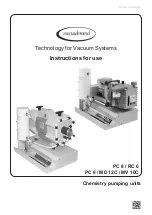
Installation and operating instructions Wilo-Sub TWU 3-...-HS (High Speed) 17
INSTALLATION English
Before the power supply cable is connected to the
switchbox/main switch, the insulation resistance
must be measured again. This way, you can iden-
tify damage caused during installation.
• Measure with an insulation tester (measuring
voltage is 500 V) to measure the resistance of the
power supply cable and the motor winding.
• The resistance must not fall below the following
values:
•
At initial commissioning: min. 20 M
Ω
•
During further measurements: min. 2 M
Ω
If the insulation resistance is too low, it is possi-
ble that moisture has penetrated into the cable
and/or motor. Do not connect the pump again
and consult the manufacturer!
If the insulation resistance is OK, connect the unit
to the mains supply by connecting the power
supply cable to the switchbox.
Electrical connections may only be made by a
qualified electrician!
The wires of the connection cable are assigned as
follows:
3-wire connection cable
Wire colour
Terminal
brown
L
blue
N
green/yellow
PE
5.5.3 Unit with external frequency converter
(TWU 3-...-HS-ECP)
The connection on the pump and mains side is
made at the frequency converter.
Electrical connections may only be made by a
qualified electrician!
Fig. 5:
Components on the frequency converter
1
Cover
5
Cable bushing
2
Housing bottom
6
“MOTOR” terminal
3
Threaded housing con-
nections
7
“LINE” terminal
4
Threaded cable connec-
tions
8
Earth terminal
Pump/frequency converter connection
The power supply cable connected at the factory
has to be extended, according to the available
space in the borehole, using heat-shrink tubing or
a cast resin connection, by the customer
before
installation
, and then connected to the frequency
converter.
Before the power supply cable is connected to
the frequency converter, the insulation resist-
ance must be measured again. This way, you can
identify damage caused during installation.
Use a round cable to extend the power supply
cable; this ensures that the cable inlet on the
frequency converter seals properly!
1. Measure with an insulation tester (measuring
voltage is 500 V) to measure the resistance of the
power supply cable and the motor winding.
The resistance must not fall below the following
values:
•
At initial commissioning: min. 20 M
Ω
•
During further measurements: min. 2 M
Ω
If the insulation resistance is too low, it is possi-
ble that moisture has penetrated into the cable
and/or motor. Do not connect the pump again
and consult the manufacturer!
2. Loosen the two screws on the housing bottom
and remove the cover.
3. Loosen the two cable inlets on the housing bot-
tom.
4. There are two terminals in the frequency con-
verter:
MOTOR and LINE. Place the threaded
cable connection on the power supply cable and
pass it through the cable inlet on the side of the
“MOTOR” terminal. Screw the threaded cable
connection into the housing and fasten the power
supply cable.
5. Pull out the terminal, connect the power supply
cable to the “MOTOR” terminal in accordance
with the wire allocation shown below, and then
replace the terminal.
4-wire connection cable
Wire colour
Terminal
black
U
blue or grey
V
brown
W
green/yellow
PE
6. Fasten the protective earth conductor to the
earth terminal above the “MOTOR” terminal. To
do this, use a blade connector.
Mains/frequency converter connection
RISK of fatal electric shock
The power supply cable on the mains side
has to be connected first to the frequency
converter and only then to the power supply
separator/switchbox! Failure to comply with
this sequence results in the full mains voltage
being present at the open cable end. There
is a risk of fatal injury! Always comply with
this sequence and have a qualified electrician
perform the electrical connection.
Use a round cable for the power supply cable;
this ensures that the cable inlet on the frequen-
cy converter seals properly!
1. Place the second threaded cable connection on
the power supply cable and pass it through the
opening on the side of the “LINE” terminal.
2. Screw the threaded cable connection into the
housing, fastening the power supply cable.











































